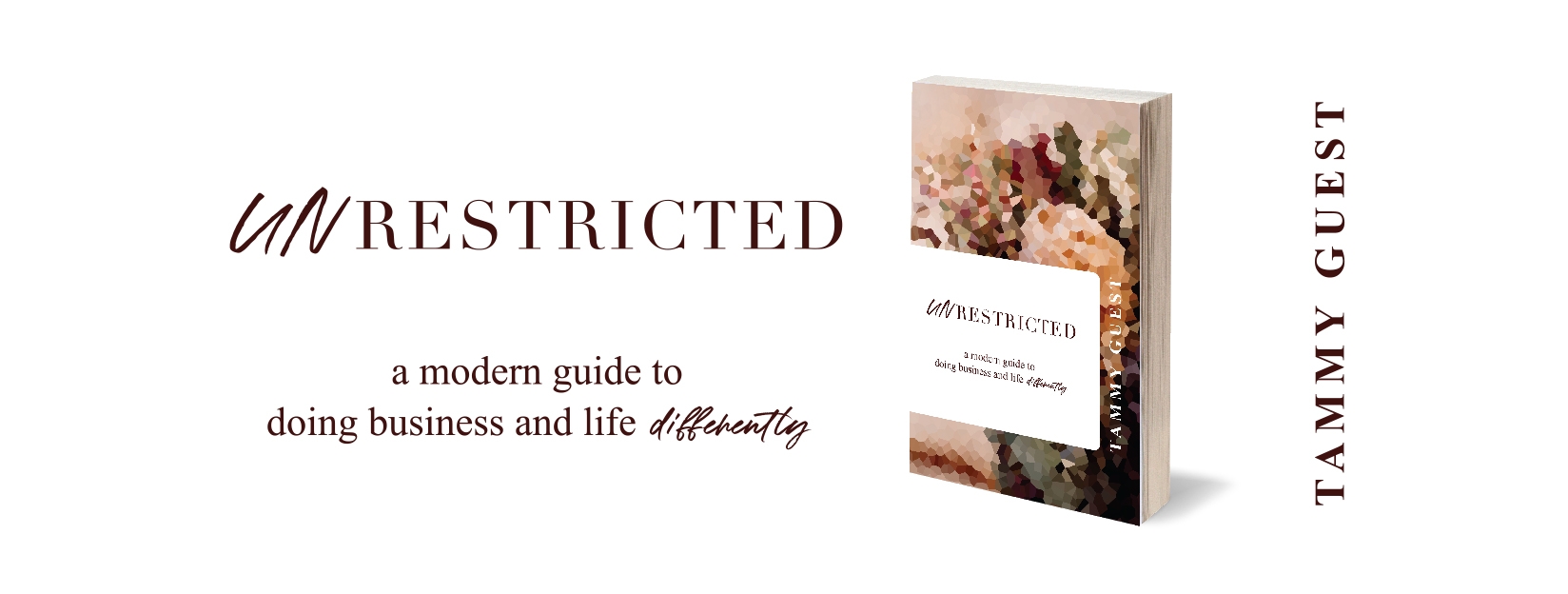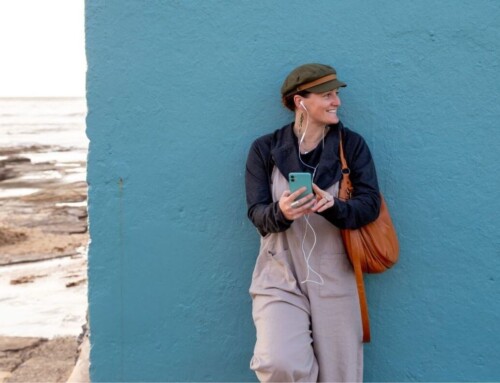A couple of questions that I hear all the time is “How to work with your partner?” and “How do you even get your partner on board in your business?”
My answer is – it’s been a long journey but it does happen.
Way back at the beginning of my first multi-modality practice, it was a really big deal. I was in my first clinic ever, all by myself in this little one office space. I divvied it up so that I could have a reception area and another area.
Murray absolutely supports me 100%. He was so excited – we both were! And just like you, we were both filling up that space. We were both finding all these different pieces of secondhand furniture or manoeuvring stuff around our house to take into the office. It’s a journey and you do it together.
Then there are moments where you’re learning along the way about how to involve somebody in something so massive an undertaking as a business. That was a really big deal for me because I’d never had a business before. No one in my family had a business before. I was just getting used to what that was all about whilst trying to have a partnership at the same time as running a family.
After some of my big expenditures in my first year, I was literally hiding the bills. It wasn’t until some of the bills started coming to our house or I left them out on a desk that Murray started to really understand what was going on. Because I wasn’t telling him. The number of clients I had then wasn’t covering the costs.
Some of the earliest things that we learnt at the beginning of getting my business up and running was around communication. Unfortunately, we learnt them through communication breakdown.
Breakthrough Is On the Other Side of Breakdown
There is usually a breakthrough on the other side of a breakdown. But I wanted to share some of the ins and outs so that you can get to a breakthrough before you have those massive breakdowns and tears from not having the conversation when it needed to be had.
Hopefully, these tips will help so that you don’t get to that point.
Tips For Communication
Communicate Clearly
Number one is about communicating clearly.
I gave you that example at the beginning hiding stuff and a lack of communication. These things are absolutely the beginnings of the crumbling of the foundation of a partnership. Any partnership – not just a business partnership but a marriage partnership and even friendships.
If you aren’t communicating and hiding your head in the sand, there’s going to be something that crumbles.
Communicating isn’t just talking, it’s also listening. It’s really important to work out a few things with your partner:
- How do they want to be listened to?
- How, when, and where do they want to be talked to?
When it all came out about those bills I’d been hiding and we started talking about how we were going to reconcile them, it was 7 o’clock on a Sunday morning in the bedroom. Not really the best time and place for that.
Sometimes just having a conversation about how you want to have conversations is really helpful! And the best time to do that is before it gets really emotional.
Because by then, those emotions – whether it’s anger, fear, frustration – will all be magnified.
So have the conversation with your partner about how can you best communicate with each other, how do you want to be talked with and at what level of detail.
Different people have different levels of detail they want about things. For instance with me and my head in the sand scenario way back at the beginning of my business, I wasn’t keen on talking about numbers at all. I know this is a really prevalent problem throughout practitioners generally. We’re just not keen in the beginning.
Murray, on the other hand, really likes detail. He really likes knowing where things come from, how they connect with all the other things, how do they work within the context of the overall plan, and how can he help with the plan.
So there we were, talking about numbers at 7 a.m. in bed on a Sunday morning. We learnt the hard way through that and set up a weekly meeting. We try our hardest to make sure it happens and we prioritise it over other things.
This makes sure that communication can stay within the context of the meeting rather than it popping up on date night. Keep it separate and keep it somewhere else if needed, but make sure that communication happens frequently.
Short, Frequent Meetings
Short, frequent meetings work great for families and even for clinics. Shorter, more frequent meetings mean the conversation can continue to happen. Whereas if you have one big huge meeting once a month, a lot of stuff has built up by that time and it doesn’t end up being as productive.
If you’re coming home from your clinic and you want to celebrate what’s going on in your clinic with your partner, that might be a good time to also bring up other pressing things and talk about those as well. The goal is for both of you to be on the same page.
However, when our partners are in a different field, they might not always be the best choice to celebrate your business with. It’s not really their job to listen to detailed accounts of your day and your clients’ successes or failures (always keeping confidentiality, of course). Something like the Natupreneur Hub is a great place to celebrate and share what’s going on in your clinics and the breakthroughs with your clients.
So just take into consideration your partner’s feelings about what kind of conversation they want to have – what do you want and what do they want? Make sure you’re both on the same page. And don’t forget to celebrate their successes, as well!
Remember – to be interesting, you first need to be interested. Think about where can you be more interested in their work. We can get bogged down in so many different hats running our own business – remember to let your stuff go once in a while and focus on theirs.
Clarity
This is all part of what we’ve already talked about, but it’s important enough that it needs its own section.
What level of detail does your partner need? What kind of context is needed to make sense of what you’re talking about?
You may randomly come out with stuff – it’s like a little piece of content – and we think that they’re supposed to know what we’re talking about. But they haven’t been on the journey, so some context may be needed to make sense of it.
Make sure you take your partner on the journey with you. Give them highlights along the way that allows them to really celebrate with you through the journey.
It’s like the hero’s journey, the entire process that you had. You’ve had lows but then you still got to the goal you wanted, in the end. Share those highs and lows, but not necessarily every detail in between. That context is so important to help someone understand what’s going on.
Provide Confidence
Really what we were discussing is that it’s a really big deal to provide confidence to your partner, especially when you’re first starting out. You’re sitting there and you don’t even know whether or not this thing’s going to work. You don’t know if you’re doing it right or wrong because you’ve probably never had a business before. You’re not quite sure because you haven’t had any clients through the door.
So how can you provide confidence to your partner with what’s going on and what you’re actually doing and where that money is going?
How did Murray get confidence after I showed him reasons to not have confidence in me (like hiding the bills! Tip: don’t hide the bills)?
Just like having a flight plan is really important when I go fly a helicopter and provides confidence to me, my partner and any passengers I might have, you need to have a flight plan for your business in place.
If you have a plan up front, or at least a skeleton of a plan about what you’re trying to achieve and how you’ll go about it, sharing that with your partner is going to help provide some confidence. Now they can see what you want to achieve and how you’re planning to go about it.
And when you achieve some of those goals, you can celebrate that momentum together.
Another way to help your partner have confidence is to allow them to help you. Perhaps it’s a bit of a masculine point of view, but perhaps they like to build things and fix things. Even though that’s a generalisation, you get the point. If there’s something that you’re building, how can your partner help? How can they help you fix something that’s not going quite?
Structure Enables Flexibility
One of my favourite quotes from Murray is, “Structure enables flexibility.”
I really feel like sometimes I’m totally in structure mode and I love the structure side of things but in general, I love flexibility! I love going with the flow. But to be able to do that in a positive way you need to have the structure first. To enable the flexibility, to enable the flow so that it doesn’t just flow out everywhere and get flattened, you need some structure.
So for instance, scheduling that time each week to catch up and share those highs and lows, as we talked about before.
Our scheduled meetings have a bit of structure. We can flex if we need to or something important comes up, but we know what’s happening and what’s coming up so that we can share in that and we can celebrate it together.
We’ve tried a lot of different things for our scheduled meetings. We used to do them outside and some other things. But now we have them Sunday afternoon and it’s as easy as going through:
- what we did last week that we want to share and celebrate
- what is coming up for the next week
- how can we support one another
- how can we ask for support (being in receiving mode as well as giving mode is really important)
In the beginning, we had those meetings at home when the kids were around or in the office. We were trying to be all clinical about it and it wasn’t working. We ended up doing a blame game.
So we changed the environment up and now we have them in the bath (we have a really big bath). We have our favourite beverage (most recently it’s cacao and sometimes it’s wine depending on what we’re celebrating).
Now we just work through that process of:
- what’s the positive – what are the wins?
- what’s the challenge coming up?
- what’s the timetable and plan for the next week?
- what do you need support with and how can I help?
It kind of goes both ways, a bit like table tennis. It’s ever-evolving, but that’s that’s our version of it at the moment.
Some people like to use whiteboards, which we have done in the past. But to diffuse the situation, create an environment that’s really yummy.
Let It Go
Anyone have kids and know the main theme song to frozen?
Let it go, let it go!
It’s really a powerful thing to say, “let it go”. Have a mindset of letting it go. It’s not always going to be perfect and maybe someone didn’t quite hear what you wanted them to hear, we didn’t quite celebrate, or they acted a certain way last time. . . just let all that go to help move it forward. The more you hang on to that, the more it’s going to hold you back.
Most of the time it makes no difference whether I’m right or wrong about something. And it’s not just one time, it’s constant. Remember, just let it go.
Remember to Connect
Two weeks ago, we went on a couple’s retreat because we are constantly committed to different goals in our business and life. One of those this year has been to make sure we connect on all sorts of levels as a couple.
One key thing out of that retreat was around closing the loop. Thinking about how to close the loop in communication, find that piece of information about something which we might have half said or we haven’t quite given all the information, come back and close that loop off. It was really impactful for us. We knew we could do better.
Closing the loop is all about having a conversation that goes all the way around. It’s remembering to share that PDF we had talked about but I hadn’t actually sent to him yet. Or having that conversation about the bills before the bookkeeper calls again. Or scheduling that conversation in rather than hiding.
This is going to lift both of our businesses and the conversation. How can we create a totally different perspective on these meetings? How can we create a different perspective on these conversations and letting all of that go?
Share Your Calendars
Google Calendar has been key in sharing our appointments. We both have access to who’s picking up the kids from school on which days this week, when one of us is travelling, catching up with friends together or separately, all those little things the kids have going on. It just removes the frustration when things are last-minute.
So this is an example of where structure gives us flexibility because everything is in the calendar and it’s so much clearer. I know there were times before we started using the Google Calendar that I would go and book some time away with a client and then Tammy would say, “But you knew that we had this on!” But I missed that or we hadn’t locked it in or I’d forgotten. With the calendar, I can look at that, Tammy can look at that, and it just removes that frustration.
It’s literally communication without you having to be there for the communication. It’s so simple and so powerful.
There are so many hacks like that but that’s been our number one hack.
Be Open to New Perspectives
One thing that Tammy touched on earlier which is really powerful is that we have adopted a mindset of not making each other wrong. Instead, we focus on what is right in the way that you approach something. I may approach it differently, but instead of thinking my way is the right way, I look to see what is right about a different approach.
We joke about who’s right and wrong and bring a bit of humour into it because it just makes it fun. But also and actually, it is so important to just realise that it doesn’t matter who’s right.
I talk about this all the time in the Club, that there isn’t actually a right and wrong, it’s just our perspectives on it. Everyone has a different perspective and can bring different gifts and talents to the conversation. If we are open and curious, we can see the entirety of a situation rather than trying to push one perspective.
We often talk about it at our retreats about seeing a cup from different angles. Depending on which side of the cup you are looking at, you will see it very differently.
It doesn’t mean that the cup is a cup without a handle on one side, and a cup with the handle on the other. It’s the same cup. No one’s right or wrong about that, it’s just a different perspective.
I also know that being a practitioner who has multiple university degrees and multiple places of knowledge reinforced with pieces of paper on the wall (and I know a lot of you are the same), we’re indoctrinated in the idea of right and wrong because that’s how we got our pieces of paper. So when we get feedback that we aren’t quite as right as we think we are – and that could be as subtle as the way somebody looks at us or the way that somebody says something to us – we feel wrong.
Our fallback mechanism is that we must be wrong, then. One of the biggest lessons I had with Murray was to not assume that he’s just trying to make me wrong. As soon as I dropped that assumption, as soon as I let go of that, I was able to be a lot more trusting with what I was sharing.
Without assuming that he’s trying to make me wrong and changing that assumption to being open and curious, I could see that he actually just wants to support me. Once I let go of that, I saw that he really just wants to help. That whole ‘Builder’ mentality he was describing was a very different perspective and lens to see him in.
Take Action
We hope this was a helpful and beneficial conversation for you and your partners, whether now or in the future. If you know somebody else who needs to hear any or all of this conversation, another practitioner or another business owner, please share it with them!
Feel free to ask any questions you may have in the comments. We’re going to be continuing this conversation for the rest of this year because Murray’s going to be joining us for quite a few more training Thursdays to share his gifts and talents, as well!
Hugs,
Tammy.










Leave A Comment